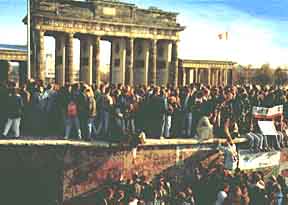Activity 3
Essential Question
- What problems result from the tension between world powers and how do they attempt to resolve these problems?
Background
With dramatic events, such as students tearing down the Berlin Wall and the Soviet Union collapsing as a country, the Cold War came to an end in 1991. Much of the world celebrated. Perhaps the world had moved into a time when at last there would be peace, but we know from history that the end of conflict rarely leads to smooth results.

The Berlin Wall
The U.S. Civil War was followed by Reconstruction, which was violent, and World War I did not make the world fully "safe for democracy," as Wilson had hoped. This essential question looks at how and why the Cold War ended and yet left a legacy that confronts us very much today.
Instructional Strategies
 |
Strategy 1 |
Computer Lab Research
Have students visit the following websites. Talk about how websites differ and how some sites are easier to use then others. Talk about the reliability of websites and the criteria for determining if a site is reliable.
You may want to review the criteria for evaluating websites. The following website is an excellent source for initiating this discussion: www.library.cornell.edu/olinuris/ref/research/webeval.html
- The History Learning Site
- Cuban Missile Crisis
- The Cold War Project
- Spartacus Website from the United Kingdom
- Greenfield History Site from the United Kingdom
Have students review the list of topics below and select one that they would like to research using the identified websites.
- Economic Competition Between the United States and the Soviet Union
- Space Exploration
- NATO and Warsaw Pact
- Cold War Issues: United States, Japan, and The German Federal Republic
- Cuban Missile Crisis
- Vietnam War
- McCarthyism
- Nuclear Testing in the 1950's - 1970's
- East/West Germany - Berlin Wall
- Education and The Cold War
- Undemocratic Regimes and The Cold war
 |
Strategy 2 |
KWLH Strategy
Discuss with the class the idea of doing "active thinking" while doing research. Tell them that it is important to focus on what they already know about a topic and to connect that information to what they are researching. Tell the class that the KWLH teaching technique is a good method to help them activate prior knowledge.Review the steps of the KWLH technique for active thinking with the class.
- K - Stands for helping students recall what they KNOW about the subject.
- W - Stands for helping students determine what they WANT to learn.
- L - Stands for helping students identify what they LEARN as they read.
- H - Stands for HOW we can learn more (other sources where additional information on the topic can be found).
Cold War Events (KWLH Chart)
| What We Know | What We Want to Find Out | What We Learned | How Can We Learn More |
|---|---|---|---|
Check for Understanding
Review a magazine article on your researched topic. Decide if the article is:
- Factual
- Concise and To the Point
- High Interest
 |
Strategy 3 |
Reading for Information
Remind students that they will be reading for information. When we read for information we read for:
- Global understanding by summarizing the text looking for the main ideas, significant details, and underlying meaning
- Developing interpretation by such strategies as comparing and contrasting what we read, looking for cause and effect and by putting things in chronological order. We also use our prior knowledge to make and confirm predictions. We also distinguish among facts, supported inferences, and opinions.
- Personal response by evaluating the new information against what we already know, evaluate the usefulness of the information, and distinguish between relevant and irrelevant information.
- Critical response by analyzing the tone of the passage and evaluate how language is used to inform or to persuade.
Model these strategies for the students prior to having them do the research.
Check for Understanding
- Use stance questions to check for understanding. Stance questions are those directly related to each of the purposes for reading.

 All Modules
All Modules Printable View
Printable View
